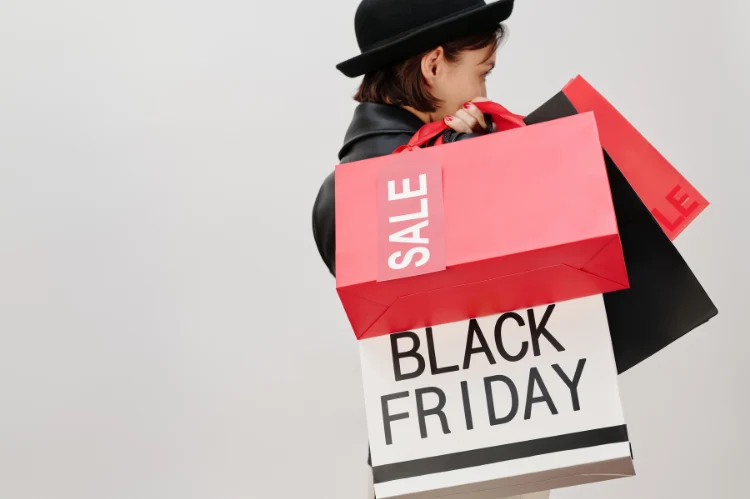Black Friday and Cyber Monday, or BFCM, has long been a time where shoppers spend big, and retailers post their biggest sales.
But things are changing. Those shopping days no longer represent the biggest source of holiday revenue. Retailers are starting sales earlier in the season, and shoppers are responding by shopping earlier. In fact, a survey from Numerator found that 63% of participants shopped deals early this year, an 11% increase over shoppers in 2020.
The data from the 4 day shopping weekend is in, and the trends in 2021 offer some significant insight into how customers are shopping this year, and what retailers should do to match.
Retail Data from Black Friday to Cyber Monday Shopping Weekend
There are some key takeaways for retailers looking to maximize shopping through December. Here are the main data points to know, and what they mean for retailers this season.
Lower online spend
According to Adobe Analytics, on Cyber Monday, customers spent $10.7 billion, a 1.4% decrease from online spending in 2020. This makes 2021 the first year that major shopping days have seen a decrease since Adobe started tracking in 2012.
What it means for retailers
Shoppers are spreading out their purchases throughout the season. Gone are the days where shoppers are waiting until the days following Thanksgiving to start on their holiday list.
What retailers should do
Don’t wait until late in December to offer promotions or offer discounts. Shoppers might be done with holiday shopping, especially online shopping, earlier this year than in past years. Last-minute shoppers are likely to be fewer this year, and are likely to have fewer items they’re purchasing at a later date.
Cart abandonment doubled
Data from Quantum Metric found that the percentage of retail traffic that abandoned before checkout nearly doubled in November compared to its numbers in 2020. One of the key reasons? An increase in supply chains issues leading to more items out of stock or with delayed shipping.
What it means for retailers
Customers who are looking for items that are out of stock are likely to go elsewhere. With ongoing sales throughout the season, and many more customers that have already gotten a jump on their holiday purchases, customers feel less urgency to make a purchase.
Getting customers to the site is only the first step. Ecommerce sites that see more retail traffic may see an equal increase in abandoned carts if they don’t meet customer needs and expectations.
What retailers can do
Create urgency. Customers are comfortable browsing and leaving filled carts on several sites when they don’t feel an immediate need to complete their purchase. Showing that a posted discount is only available for a limited time, especially if a product in the cart is one of a few remaining, can help push customers to checkout sooner. If shipping delays are a concern, consider having a countdown with the date by which customers should order to get their purchase by the holidays.
A key way to increase conversion rate is through adding valuable offers that encourage customers to move forward with the purchase. Product protection increases conversion through giving them the confidence to make a purchase when they have the assurance that their product will be backed for an amount of time.
Fewer, and smaller, discounts
Shoppers didn’t see huge drops in prices this shopping weekend. Salesforce reported that the average product discount in the US was 26%, an 8% decrease from the previous year.
What it means for retailers
Smaller discounts weren’t surprising due to rising costs over the year for many retailers. In addition, with sales starting earlier in the season, many retailers had already offered discounts since October, rather than waiting for BFCM weekend to release their biggest deals.
What retailers should do
Slashing your prices with massive discounts can make you stand out, but it comes at the expense of a lot of revenue. To promote your product without drastically cutting into your bottom line, emphasize differentiators that make your product valuable. Promote offerings like Buy Now Pay Later options and product protection as a low-cost add-on in order to add extra value to your products.
Increase in curbside pickup orders
Curbside shopping has continued to gain steam as a popular option. Shopify found that the average curbside pickup cart price in 2021 increased to $96.60 from a cart cost of $79.84 in 2020.
What it means for retailers
With highly publicized supply chain issues and anticipated shipping delays, customers are concerned about their purchases arriving on time. Curbside shopping meets customer needs through providing the convenience of online shopping with the security of picking up an order rather than waiting on shipping.
What retailers should do
Provide the reassurance that customers want to help them feel confident in their purchase. Customers will be looking to post-purchase emails as a way to get shipping updates to let them know when the product will arrive. Offering product protection in post-purchase emails is a great way to provide peace of mind to customers that they’re getting lasting value out of their product as they’re waiting for it to arrive.
Provide comfort to customers earlier in the customer journey with shipping time estimates as they're adding items to the cart. Post a date by which customers they need to complete their order in order to get it in time for the holidays. Offer updates on shipping or supply delays, including updating any out of stock items before customers try to buy.
High estimates for full-season revenue
The National Retail Federation has forecast that the shopping season from November to December will grow between 8.5 - 10.5% over holiday shopping in 2020. That will put total retail for those months between $843.4 billion and $859 billion.
What it means for retailers
Despite a dip in online spending over the weekend, holiday retail is expected to hit a new high. Whether you saw big gains over the BFCM weekend or had lower than hoped for traffic, the chance isn’t over to capture additional revenue this season.
What retailers should do
Maximize the revenue from each customer with a quality product add-on strategy. Relevant add-on suggestions increase AOV while making a customer’s shopping experience easier. Don’t forget post-purchase emails as a valuable opportunity to get additional revenue through bringing customers back to the site for a second purchase or to add a product protection plan onto their product.
Maximize Holiday Shopping Through December
The BFCM weekend 2021 brought some big shifts from last year's trends. With lower online spend, higher cart abandonment, smaller retail discounts, an increase in curbside shopping, and projected high season revenue, the weekend revealed what customers want. By learning from the takeaways from these insights, you can maximize your retail success this December, and be prepared for the retail challenges of 2022.





